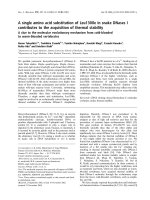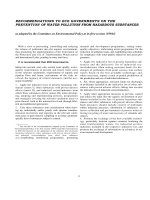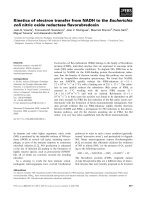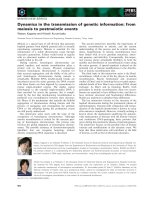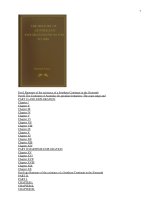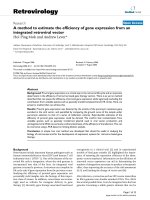The foundations of chaos revisited from poincaré to recent advancements
Bạn đang xem bản rút gọn của tài liệu. Xem và tải ngay bản đầy đủ của tài liệu tại đây (9.52 MB, 268 trang )
Understanding Complex Systems
Christos Skiadas Editor
The Foundations
of Chaos Revisited:
From Poincaré
to Recent
Advancements
Springer Complexity
Springer Complexity is an interdisciplinary program publishing the best research and
academic-level teaching on both fundamental and applied aspects of complex systems –
cutting across all traditional disciplines of the natural and life sciences, engineering,
economics, medicine, neuroscience, social and computer science.
Complex Systems are systems that comprise many interacting parts with the ability to
generate a new quality of macroscopic collective behavior the manifestations of which are
the spontaneous formation of distinctive temporal, spatial or functional structures. Models
of such systems can be successfully mapped onto quite diverse “real-life” situations like
the climate, the coherent emission of light from lasers, chemical reaction-diffusion systems,
biological cellular networks, the dynamics of stock markets and of the internet, earthquake
statistics and prediction, freeway traffic, the human brain, or the formation of opinions in
social systems, to name just some of the popular applications.
Although their scope and methodologies overlap somewhat, one can distinguish the
following main concepts and tools: self-organization, nonlinear dynamics, synergetics,
turbulence, dynamical systems, catastrophes, instabilities, stochastic processes, chaos, graphs
and networks, cellular automata, adaptive systems, genetic algorithms and computational
intelligence.
The three major book publication platforms of the Springer Complexity program are the
monograph series “Understanding Complex Systems” focusing on the various applications
of complexity, the “Springer Series in Synergetics”, which is devoted to the quantitative
theoretical and methodological foundations, and the “SpringerBriefs in Complexity” which
are concise and topical working reports, case-studies, surveys, essays and lecture notes of
relevance to the field. In addition to the books in these two core series, the program also
incorporates individual titles ranging from textbooks to major reference works.
Editorial and Programme Advisory Board
Henry Abarbanel, Institute for Nonlinear Science, University of California, San Diego, USA
Dan Braha, New England Complex Systems Institute and University of Massachusetts Dartmouth, USA
Péter Érdi, Center for Complex Systems Studies, Kalamazoo College, USA and Hungarian Academy
of Sciences, Budapest, Hungary
Karl Friston, Institute of Cognitive Neuroscience, University College London, London, UK
Hermann Haken, Center of Synergetics, University of Stuttgart, Stuttgart, Germany
Viktor Jirsa, Centre National de la Recherche Scientifique (CNRS), Université de la Méditerranée, Marseille,
France
Janusz Kacprzyk, System Research, Polish Academy of Sciences, Warsaw, Poland
Kunihiko Kaneko, Research Center for Complex Systems Biology, The University of Tokyo, Tokyo, Japan
Scott Kelso, Center for Complex Systems and Brain Sciences, Florida Atlantic University, Boca Raton, USA
Markus Kirkilionis, Mathematics Institute and Centre for Complex Systems, University of Warwick,
Coventry, UK
Jürgen Kurths, Nonlinear Dynamics Group, University of Potsdam, Potsdam, Germany
Andrzej Nowak, Department of Psychology, Warsaw University, Poland
Hassan Qudrat-Ullah, School of Administrative Studies, York University, Toronto, ON, Canada
Peter Schuster, Theoretical Chemistry and Structural Biology, University of Vienna, Vienna, Austria
Frank Schweitzer, System Design, ETH Zurich, Zurich, Switzerland
Didier Sornette, Entrepreneurial Risk, ETH Zurich, Zurich, Switzerland
Stefan Thurner, Section for Science of Complex Systems, Medical University of Vienna, Vienna, Austria
Understanding Complex Systems
Founding Editor: S. Kelso
Future scientific and technological developments in many fields will necessarily
depend upon coming to grips with complex systems. Such systems are complex in
both their composition – typically many different kinds of components interacting
simultaneously and nonlinearly with each other and their environments on multiple
levels – and in the rich diversity of behavior of which they are capable.
The Springer Series in Understanding Complex Systems series (UCS) promotes
new strategies and paradigms for understanding and realizing applications of
complex systems research in a wide variety of fields and endeavors. UCS is
explicitly transdisciplinary. It has three main goals: First, to elaborate the concepts,
methods and tools of complex systems at all levels of description and in all scientific
fields, especially newly emerging areas within the life, social, behavioral, economic,
neuro- and cognitive sciences (and derivatives thereof); second, to encourage novel
applications of these ideas in various fields of engineering and computation such as
robotics, nano-technology and informatics; third, to provide a single forum within
which commonalities and differences in the workings of complex systems may be
discerned, hence leading to deeper insight and understanding.
UCS will publish monographs, lecture notes and selected edited contributions
aimed at communicating new findings to a large multidisciplinary audience.
More information about this series at />
Christos Skiadas
Editor
The Foundations of Chaos
Revisited: From Poincaré
to Recent Advancements
123
Editor
Christos Skiadas
ManLab Technical University of Crete
Chania, Greece
ISSN 1860-0832
ISSN 1860-0840 (electronic)
Understanding Complex Systems
ISBN 978-3-319-29699-9
ISBN 978-3-319-29701-9 (eBook)
DOI 10.1007/978-3-319-29701-9
Library of Congress Control Number: 2016938786
© Springer International Publishing Switzerland 2016
This work is subject to copyright. All rights are reserved by the Publisher, whether the whole or part of
the material is concerned, specifically the rights of translation, reprinting, reuse of illustrations, recitation,
broadcasting, reproduction on microfilms or in any other physical way, and transmission or information
storage and retrieval, electronic adaptation, computer software, or by similar or dissimilar methodology
now known or hereafter developed.
The use of general descriptive names, registered names, trademarks, service marks, etc. in this publication
does not imply, even in the absence of a specific statement, that such names are exempt from the relevant
protective laws and regulations and therefore free for general use.
The publisher, the authors and the editors are safe to assume that the advice and information in this book
are believed to be true and accurate at the date of publication. Neither the publisher nor the authors or
the editors give a warranty, express or implied, with respect to the material contained herein or for any
errors or omissions that may have been made.
Printed on acid-free paper
This Springer imprint is published by Springer Nature
The registered company is Springer International Publishing AG Switzerland
Preface
Henri Poincaré is considered to be one of the great minds of mathematics, physics,
and astronomy. Apart from his rigorous mathematical and analytical style, he was
also renowned for his deep insights into science and the philosophy of science. He
developed and contributed to many important scientific achievements, and his works
on the foundations of science, scientific hypothesis, and scientific method were
written with elegance and style. Even more significantly, perhaps, he came to bear
upon recent scientific achievements when he put forward the Poincaré conjecture,
thereby introducing geometry and topology into the analysis of shape and form.
The Poincaré conjecture and his work on the three-body problem are considered to
constitute the foundations of the modern chaos theory.
This book The Foundations of Chaos Revisited: From Poincaré to Recent
Advancements was motivated by the CHAOS 2015 International Conference at
the Henri Poincaré Institute in Paris. This was undoubtedly the best place to gain
insight into chaos theory as inspired by the Poincaré tradition in a place that must
be considered as the home of Poincaré or, better, the home of mathematics in Paris.
In order to explore the foundations of chaos theory in greater depth, the aim
was to approach the main theme with the style and elegance of Henri Poincaré,
as exemplified in his mathematical-analytical formulation. Chaos theory provides
a link between science and the humanities. It is one of the few scientific topics
that tends to unify the different areas of science and to connect them with society
as a whole and with a language, CHAOS, that is generally accepted as providing
a common substrate, even if this substrate can be seen as mathematics, geometry,
graphs, or linguistic material, depending on your viewing point. However, all would
accept that chaos theory brings together a very broad range of fields.
Following a proposal by Christian Caron from Springer, we have asked the
plenary and keynote speakers of the conference to contribute to a book with
an extended version of their presentations, the aim being to connect Poincaré’s
contributions with today’s achievements. We are happy that we have already
received contributions of high caliber that will take the reader on a fascinating tour
of chaos theory. Important applications integrating traditional and modern chaos
theory are included in the final chapters of this book.
v
vi
Preface
Ferdinand Verhulst has already published several contributions on the Henri
Poincaré legacy. With his elegant style and deep understanding of the state of
science, especially in mathematics and physics, both during and prior to the days
when Poincaré was active, he presents a brilliant paper entitled “Henri Poincaré’s
Inventions in Dynamical Systems and Topology.” He explains how Poincaré’s
broad knowledge of the existing literature led to such outstanding contributions to
dynamical systems and topology. The latter achievement was also built upon the
foundations in geometry and geometric representations of mathematical problems
prevalent in the French school. The Poincaré map exemplifies Poincaré’s deep
insight into the way geometric visualization can lead to progress in mathematical
modeling and especially chaotic modeling.
Jean-Mark Ginoux, a biographical expert on Poincaré who has made good use
of the “Archives Henri Poincaré,” has contributed a paper entitled “From Nonlinear
Oscillations to Chaos Theory.” Following on from the first chapter by Ferdinand
Verhulst, he proceeds to explain how Poincaré’s mathematical concept of limit
cycle and the existence of sustained oscillations representing a stable regime of
sustained waves contributed to the advancement of theory and practice in radio
communications. The author provides documentation and an excellent presentation
of the three main devices, the series-dynamo machine, the singing arc, and the
triode, over a period ranging from the end of the nineteenth century till the end
of the Second World War. He shows how Van der Pol’s study of the oscillations
of two coupled triodes and the forced oscillations of a triode led, at the end of the
Second World War, to Mary Cartwright and John Littlewood’s characterization of
the related oscillating behavior as “bizarre.” This behavior would later be identified
as “chaotic.” However, the basis of this achievement was set forty years earlier
by Poincaré in his work La Théorie de Maxwell et les oscillations Hertziennes:
la télegraphie sans fil (Gauthier-Villars, 3e ed. (Paris), 1907).
The early 1940s were a milestone for the characterization of nonlinear and
“bizarre” oscillations, or better “fine structure solutions,” to use the more elegant
terminology for chaotic solutions in wave modeling in telecommunications. Then,
in 1941 the Russian researcher A.N. Kolmogorov began modeling the chaotic
phenomenon in fluid flow known as turbulence. It was an important step to pass from
oscillations to waves in flows and turbulence. However, the limit cycles introduced
by Poincaré in the solution of differential equations were a key achievement underpinning progress that would be made some decades later. And even more important
was his paper on rotating fluids: “Sur la stabilité de l’équilibre des figures piriformes
affectées par une masse fluide en rotation,” Poincaré, H. (1901) Philosophical
Transactions A 198, 333–373. David Ruelle contributes to this important topic with
an extended paper from the honorary presentation for his eightieth birthday at the
CHAOS 2015 International Conference at the Henri Poincaré Institute in Paris. This
paper follows up with further comments by Giovanni Gallavotti and Pedro Garrido,
who also discuss related computer applications. From the early 1970s, with their
seminal paper “On the Nature of Turbulence,” Ruelle and Takens helped to bring
forward Kolmogorov’s ideas, while over the last few years (2012, 2014), David
Ruelle has extended his contributions to the nonequilibrium statistical mechanics
Preface
vii
of turbulence. Note that the related work of Kolmogorov was mainly on an ideal
form of homogeneous and isotropic turbulence, whereas Ruelle is working on
the problem of real nonhomogeneous turbulence, where the lack of homogeneity
is called intermittency. According to David Ruelle, his paper integrates ideas of
turbulence and heat flow:
Translating a nonequilibrium problem (turbulence) into another nonequilibrium problem
(heat flow) is in principle an interesting idea, but there are two obvious difficulties:
• Expressing the fluid Hamiltonian as the Hamiltonian of a coupled system of nodes is
likely to give complicated results.
• The rigorous study of heat flow is known to be extremely hard.
What we shall do is to use crude (but physically motivated) approximations, with the hope
that the results obtained are in reasonable agreement with experiments. This is indeed the
conclusion of our study, indicating that turbulence lies naturally within accepted ideas of
nonequilibrium statistical mechanics.
Giovanni Gallavotti and Pedro Garrido follow Ruelle’s paper “Non-equilibrium
Statistical Mechanics of Turbulence” with “Comments on Ruelle’s Intermittency
Theory.” Giovanni Gallavotti has made significant contributions to chaos theory and
applications in the late 1970s and has published a book entitled Foundations of Fluid
Dynamics. Here, in this joint paper with Garrido, they present an intermittency correction term to the classical Kolmogorov law. Many calculations are presented for
various cases of turbulence and for different Reynold’s numbers, thus strengthening
the related theory.
Following the previous papers, Roger Lewandowski and Benoît Pinier contribute
with a paper “The Kolmogorov Law of Turbulence: What Can Rigorously Be
Proved?” They consider how homogeneity and isotropy are introduced into turbulence and give a mathematical proof of the famous -5/3 Kolmogorov law. Their aim
is to:
1. Carefully express the appropriate similarity assumption that a homogeneous and
isotropic turbulent flow must satisfy in order to derive the -5/3 law
2. Derive the -5/3 law theoretically from the similarity assumption
3. Discuss the numerical validity of such a law from a numerical simulation in a test case,
using the software BENFLOW 1.0, developed at the Institute of Mathematical Research
in Rennes
They use the Navier-Stokes equations and refer to work by Boussinesq: “Essai
sur la théorie des eaux courantes.” Mémoires présentés par divers savants à
l’Académie des Sciences (Paris, 23.1.1877, 1–660). Another approach is given in
“Sur la stabilité de l’équilibre des figures piriformes affectées par une masse fluide
en rotation,” Poincaré, H. (1901), Philosophical Transactions A 198, 333–373.
Pierre Coullet and Yves Pomeau present a very important topic under the
title “History of Chaos from a French Perspective.” This is an exceptional paper,
deserving much attention. Every point is presented with clarity and a deep insight
into the subject. They start with Poincaré and the French tradition in dynamical
systems. As they explain:
viii
Preface
The history of chaos begins with Poincaré. His PhD thesis can be seen as the very beginning
of dynamics as we know it. He invented powerful geometrical methods to understand
“qualitatively” the behavior of solutions of ordinary differential equations. His message
remains alive, because of the power of his methods. As a side remark it is curious to see
his basic concepts rediscovered again and again. The saddle-node bifurcation (noeud-col
in Poincaré thesis) has grown popular in this respect and lately has acquired various fancy
new names. Poincaré not only pioneered qualitative methods for the analysis of differential
equations, but he also began to study dissipative dynamical systems that differed from
the (far more complex) methods of Lagrangian dynamics (a topic where he also brought
fundamental ideas).
In the same style they continue with a fascinating presentation, discussing authors
and researchers, theoreticians and experimentalists, and the interaction between
them, as well as scientific progress in the field of chaos. They conclude:
Clearly, chaos theory and experiment has not suffered from lack of attractiveness. Nowadays
it has morphed into the wider field of nonlinear science, drawing in many bright young
colleagues. We hope this tree will continue to blossom.
Orbits and periodic orbits in a topological environment, maps, and related
presentations all started with Poincaré, to be expanded later in a well-known paper
by V. Arnold entitled: “Small Denominators. I. Mapping of the Circumference
onto Itself” (Amer. Math. Soc. Transl. (2), 46:213–284, 1965). Quasiperiodicity
is explored in the paper by Suddhasattwa Das, Yoshitaka Saiki, Evelyn Sander,
and James A. Yorke. They provided a one-dimensional quasiperiodic map as an
example and showed that their weighted averages converged far faster than the usual
rate of O(1 N), provided f was sufficiently differentiable. They used this method
for efficient numerical computation of rotation numbers, invariant densities, and
conjugacies of quasiperiodic systems and also to provide evidence that the changes
of variables were (real) analytic. James Yorke was an invited plenary speaker at the
CHAOS 2015 International Conference. He is one of the main contributors to chaos
theory with many papers to his name. Two of the best are “Period Three Implies
Chaos,” T.Y. Li, and J.A. Yorke, American Mathematical Monthly 82, 985 (1975),
and “Controlling Chaos,” E. Ott, C. Grebogi, and J.A. Yorke, Phys. Rev. Lett. 64,
1196–1199 (1990).
Alexander Ramm has explored the problem of heat transfer in a complex
medium. He has already investigated the scattering of acoustic and electromagnetic
waves by small bodies of arbitrary shapes and discussed applications to the creation
of new engineered materials. These are very important contributions to a subject that
has many practical applications in the production of modern materials with special
characteristics.
Theory and practice suggests that time delays are connected with chaotic
behavior, and this is explained in the paper by V.J. Law, W.G. Graham, and D.P.
Dowling entitled “Plasma Hysteresis and Instability: A Memory Perspective”. They
start with a historical review of the significance of Duddell’s “singing arc” and its
application to deleterious effects in the control of both hysteresis and spatiotemporal
stability as the two-electrode valve evolved into the three-electrode or triode vacuum
tube. They illustrate the use of oscillograph Lissajous figures in the I-V plane,
Preface
ix
the Q-V plane, and the harmonic plane to investigate these deleterious effects
in modern low-pressure parallel-plate systems and atmospheric pressure plasma
systems and compare the hysteresis and stability within the “singing arc.” They
discuss developments from the original oscillograph measurement to today’s analog,
digital, and software methods. They also ask whether the “singing arc” and other
plasma systems fall in the category of a memory element. The authors explain
Poincaré’s achievements in this area:
A recent reevaluation of the work of Henri Poincaré has revealed that he too played a
significant role in the mathematical understanding of the arc’s stable regime using limit
cycles and their deviation from that regime. Even though Poincaré did not study the triode
vacuum tube, the review claims that the two-electrode “singing arc” is analogous to the
three-electrode or triode vacuum tube. Given the extended triode development time line,
it would seem unlikely that, at Poincaré’s wireless telegraphy conference in 1908 or at the
time close to his death in 1912, he was able to deduce or describe the behavior of early triode
vacuum tubes that operated under soft or hard vacuum conditions. Nevertheless, Poincaré’s
closed limit cycles do predate the work of Van de Pol and J. Van de Mark along with
Andronov self-oscillations.
The Indian scientist Sir Chandrasekhara Venkata Raman earned the 1930 Nobel
Prize in physics for his work in the field of light scattering and the development
of the so-called Raman amplifiers. Following this discovery, several theoretical and
applied studies led to the construction of new scientific fields, including the fiber
Raman amplifiers presented in a paper by Vladimir L. Kalashnikov and Sergey
V. Sergeyev entitled “Stochastic Anti-resonance in Polarization Phenomena.” To
treat this problem, the authors based their work on the classical Poincaré sphere,
an analytic tool first developed in Poincaré’s publication: “Les methodes nouvelles
de la mecanique celeste” (Tome I, Paris, 1892, Gauthier-Villars). The authors put
forward a more general analytic framework, useful in many topics, as discussed in
their paper:
Here we shall demonstrate a cooperation between analytical multi-scale techniques and
direct numerical simulations of SDEs that reveals a quite nontrivial phenomenon, stochastic
antiresonance (SAR). This can be characterized by different signatures, including the Hurst
parameter, the Kramers length, the standard deviation, etc. This phenomenon can be treated
as a noise-driven escape from a metastable state which is intrinsic to diffusion in crystals,
protein-folding, activated chemical reactions, and many other contexts. As a test bed, we
consider a fiber Raman amplifier with random birefringence, a device with a direct practical
impact on the development of high-transmission-rate optical networks.
Many applications of chaos are based on differential equations and systems
of differential equations. Right from the beginning, when methods were first
introduced to solve differential equations, it was evident that exact solutions would
not generally exist in the majority of applications. Still other scientific advancements
relating to second-order differentials had to wait until Ito and Stratonovich came
on the scene in the twentieth century, establishing the stochastic theory already
introduced in another form by Paul Langevin (1908). Poincaré’s great achievement
is illustrated by the fact that, very early in his career, in fact, in his PhD dissertation,
he had suggested a qualitative approach to solving differential equations, including
limit cycles and singular or stationary points, while he had introduced the term
x
Preface
“bifurcation” in his first paper on mathematics (1885). It is interesting to see
how important these tools have become today. The paper by Irene M. Moroz,
Roger Cropp, and John Norbury entitled “A Simple Plankton Model with Complex
Behaviour” includes all the recipes provided by Poincaré to deal with a coupled
system of four nonlinear differential equations, including phase portraits, critical or
equilibrium points, bifurcation diagrams, and chaotic oscillations. This paper is a
typical example of the importance of Poincaré’s findings across a broad range of
theoretical and applied fields in science.
An interesting application, entitled “Fractal Radar: Towards 1980–2015,” is
included in the paper by Alexander A. Potapov, along with an interesting approach
to the theory of fractional measure and nonintegral dimension. According to the
author:
The main feature of fractals is the nonintegral value of its dimension. The development
of dimension theory began with the work of Poincaré, Lebesgue, Brauer, Urysohn, and
Menger. Sets which are negligibly small and indistinguishable in one way or another in the
sense of Lebesgue measure arise in different fields of mathematics. To distinguish such sets
with a pathologically complicated structure, one should use unconventional characteristics
of smallness, for example, Hausdorff’s capacity, potential, measures, dimension, and so on.
The application of the fractional Hausdorff dimension associated with entropy, fractals, and
strange attractors has turned out to be most fruitful in dynamical systems theory.
Irina N. Pankratova and Pavel A. Inchin explore a “Simulation of Multidimensional Nonlinear Dynamics by One-Dimensional Maps with Many Parameters.”
They propose a class of discrete dynamical systems as nonlinear matrix models
to describe multidimensional multiparameter nonlinear dynamics. In their article,
they simulate the system’s asymptotic behavior by introducing a two-step algorithm
to compute !-limit sets of dynamical systems. They propose a qualitative theory
allocating invariant subspaces of the system matrix that contain cycles of rays on
which the !-limit sets of the dynamical systems are situated, and they introduce
dynamical parameters to describe the system behavior. The !-limit set of the system
trajectory is computed using the analytical form of the one-dimensional nonlinear
Poincaré map determined by the dynamical parameters.
The paper “Sudden Cardiac Death and Turbulence” authored by Guillaume
Attuel, Oriol Pont, Binbin Xu, and Hussein Yahia is another important application
of the theories presented in the first part of this book, including Poincaré’s methods
and Y. Pomeau’s conjecture regarding hydrodynamic intermittency. This is a clear
and concise discussion of one of the main causes of death in our societies. Many
of the theoretical tools of chaos theory are used, including abnormal oscillations,
fluctuations, and limit cycles. A system of four coupled differential equations is
introduced, and Poincaré section plots are presented, along with an analysis of the
onset of turbulence.
The paper by Philippe Beltrame entitled “Absolute Negative Mobility in a
Ratchet Flow” relates to the papers of David Ruelle, Jean-Mark Ginoux, and
Alexander Ramm. The problem is modeled by a simple system and by a system
of four coupled nonlinear differential equations. Bifurcation diagrams, period-
Preface
xi
doubling cascades, critical values, strange attractors, and Poincaré sections are
presented along with a discussion of the chaotic transition.
Given the selection of papers in the book, the aim here is to reach a broad
scientific and general audience. Indeed, it is directed not only at researchers and
scientists in almost every field but also at a wider audience interested in discovering
and exploring the way modern chaos theory was brought into being some 120
years ago by a brilliant scientist who had the intellectual ability and the scientific
knowledge to reach both the heart and the boundaries of this theory.
We are grateful for the valuable support of Christian Caron, who first suggested
this book devoted to the Poincaré legacy, and to Springer for publishing it. Our
deepest thanks go to the authors and to the direction of the Henri Poincaré Institute
in Paris for accepting to host the CHAOS 2015 International Conference, including
the staff of the Institute who ensured the success of the conference in a scientifically
inspiring environment.
Chania, Greece
December 2015
Christos Skiadas
Contents
1
Henri Poincaré’s Inventions in Dynamical Systems and Topology .. . .
Ferdinand Verhulst
1
2
From Nonlinear Oscillations to Chaos Theory . . . . . .. . . . . . . . . . . . . . . . . . . .
Jean-Marc Ginoux
27
3
Hydrodynamic Turbulence as a Nonstandard Transport
Phenomenon.. . . . . . . . . . . . . . . . . . . . . . . . . . . . . . . . . . . . . . . . . . . .. . . . . . . . . . . . . . . . . . . .
David Ruelle
4
Non-equilibrium Statistical Mechanics of Turbulence . . . . . . . . . . . . . . . . .
Giovanni Gallavotti and Pedro Garrido
5
The Kolmogorov Law of Turbulence What Can Rigorously
Be Proved? Part II . . . . . . . . . . . . . . . . . . . . . . . . . . . . . . . . . . . . . .. . . . . . . . . . . . . . . . . . . .
Roger Lewandowski and Benoît Pinier
49
59
71
6
History of Chaos from a French Perspective . . . . . . . .. . . . . . . . . . . . . . . . . . . .
Pierre Coullet and Yves Pomeau
91
7
Quasiperiodicity: Rotation Numbers . . . . . . . . . . . . . . . . .. . . . . . . . . . . . . . . . . . . . 103
Suddhasattwa Das, Yoshitaka Saiki, Evelyn Sander,
and James A. Yorke
8
Heat Transfer in a Complex Medium . . . . . . . . . . . . . . . .. . . . . . . . . . . . . . . . . . . . 119
A.G. Ramm
9
Plasma Hysteresis and Instability: A Memory Perspective . . . . . . . . . . . . 137
V.J. Law, W.G. Graham, and D.P. Dowling
10 Stochastic Anti-Resonance in Polarization Phenomena .. . . . . . . . . . . . . . . 159
Vladimir L. Kalashnikov and Sergey V. Sergeyev
11 A Simple Plankton Model with Complex Behaviour . . . . . . . . . . . . . . . . . . . 181
Irene M. Moroz, Roger Cropp, and John Norbury
xiii
xiv
Contents
12 Chaos Theory, Fractals and Scaling
in the Radar: A Look from 2015 .. . . . . . . . . . . . . . . . . . . . .. . . . . . . . . . . . . . . . . . . . 195
Alexander A. Potapov
13 Simulation of Multidimensional Nonlinear Dynamics
by One-Dimensional Maps with Many Parameters.. . . . . . . . . . . . . . . . . . . . 219
Irina N. Pankratova and Pavel A. Inchin
14 Sudden Cardiac Death and Turbulence . . . . . . . . . . . . . .. . . . . . . . . . . . . . . . . . . . 235
Guillaume Attuel, Oriol Pont, Binbin Xu, and Hussein Yahia
15 Absolute Negative Mobility in a Ratchet Flow . . . . . .. . . . . . . . . . . . . . . . . . . . 249
Philippe Beltrame
Chapter 1
Henri Poincaré’s Inventions in Dynamical
Systems and Topology
Ferdinand Verhulst
Abstract The purpose of this article is to trace the invention of images and concepts
that became part of Poincaré’s dynamical systems theory and the Analysis Situs.
We will argue that these different topics are intertwined whereas for topology
Riemann surfaces and automorphic functions play an additional part. The introduction explains the term invention in the context of Poincaré’s philosophical ideas.
Poincaré was educated in the school of Chasles and Darboux that emphasized the
combination of analysis and geometry to perform mathematics fruitfully. This will
be illustrated in the second section where we list his new concepts and inventions in
dynamical systems, followed by the descriptions of theory available before Poincaré
started his explorations and the theory he developed. The third section studies in the
same way the development of Poincaré’s topological thinking that took place in the
same period of time as his research in dynamical systems theory.
1.1 Introduction
The purpose of this paper is to trace the inventions of Poincaré regarding dynamical
systems and topology starting with the accepted knowledge of his time. As we will
see, for topology we will have to discuss aspects of the theory of automorphic
functions. The intertwining of analysis and geometry is typical for the scientific
work of Henri Poincaré.
This paper will not be a systematic treatment of his achievements and their
impact on later science. Such systematic descriptions and references can be found
in the biographies [8] and [31].
The use of the word ‘invention’ in the title needs some explanation. One should
note that the first meaning of invention in French, as Poincaré used it, is indeed the
same as in English.
F. Verhulst ( )
Mathematisch Instituut, University of Utrecht, PO Box 80.010, 3508 TA Utrecht,
The Netherlands
e-mail:
© Springer International Publishing Switzerland 2016
C. Skiadas (ed.), The Foundations of Chaos Revisited: From Poincaré to Recent
Advancements, Understanding Complex Systems,
DOI 10.1007/978-3-319-29701-9_1
1
2
F. Verhulst
A famous essay by Henri Poincaré in [16] has the title “L’invention mathématique”. In [31, p. 84] the essay is described as follows:
In a wonderful piece of introspection, Poincaré describes in the essay how sudden insight
came to him in solutions of mathematical problems. He conjectures that the unconscious
mind, stimulated by intense but seemingly fruitless exploration of a problem by the
conscious mind, considers many mathematical combinations and makes a choice on the
basis of aesthetics and economy. An example that he gives of such an occurrence concerns
the Fuchsian functions.
There has been a lot of confusion about the use of this term. The English translation
of [16] uses “discovery” instead of “invention”, see [18, p. 46]. Even recently in [8,
p. 120] this produced the following mix-up:
In 1908 Poincaré talked to the Société de Psychologie in Paris about the psychology
of discovery of new results in mathematics. The published version in L’enseignement
mathématique, “L’invention mathématique,” became one of his more famous essays.
The mix-up of discovery and invention is repeated on p. 120 of [8].
People argue that, starting with a complete system of axioms, mathematics is not
invented but discovered. Of course discovery applies to a result like:
Assuming Euclides’ axioms in plane geometry, we have that the sum of the
angles within a triangle is 180 degrees.
Such results were discovered by careful analysing and following up the given
assumptions.
When Poincaré uses the term invention he refers to the creation of new concepts
or the identification of deep relations between different mathematical or physical
concepts.
Platonic reasoning would argue for instance that the integers or the prime
numbers exist independently of the human mind. However, long after identifying
three apples or nine trees, the human mind came up with the abstract notion of
number, for instance 3 or 9, as an element of the set of integers. An integer (and
the set of integers) has no relation to a physical phenomenon, it exists only as an
abstraction in the human mind; it is an example of human invention. It became the
inspiration for the concept of operations like multiplication, a subsequent invention.
And this was followed by the concept of multiplication of elements of other sets, for
instance complex numbers, quaternions, matrices, elements of vectorspaces, etc.
Closely related to the idea of invention is the importance Poincaré attributes to
language in [15]. The scientist creates the language to describe phenomena; to find
the most suitable verbal description is an essential element of understanding the
phenomena, both in the natural sciences and in mathematics. The perception of the
relation between concepts and phenomena needs expression in language, which is
an ingredient of the process of scientific invention. An example given by Poincaré
concerns the motion of the celestial bodies. Kepler’s laws contain a description in
terms of the motion of the planets in elliptical orbits; the geometric concept of an
ellipse provided the language. The transition to Newton’s laws produced a richer
formulation resulting in deeper understanding; the analytic concept of differential
equation provided the language.
1 Henri Poincaré’s Inventions in Dynamical Systems and Topology
3
A concept introduced in [17] gives another illustration of the language for a
new concept. Poincaré reasons that the classification of scientific facts is a main
part of the activity of scientists. One considers for instance in biology all living
creatures on Earth and tries to classify them in various groups. Or one considers
in mathematics the set of integers and tries to distinguish subsets as even or odd
numbers. A classification makes sense if adding new elements to the set does not
change the old classification. For instance in biology, the discovery of a new type
of living creature in the deep oceans, does not change the ‘definition’ of birds or
mammals. If a classification is not changed by adding new elements, it is called
predicative by Poincaré. This is now an accepted concept in logic. A definition in
mathematics is really a classification, a definition has to be predicative.
Poincaré gives a simple example. Consider the set of integers and as a subset H
the first hundred integers. Classify them in two subsets: A, the numbers one through
ten and B, the numbers larger than ten. Embedding H in a larger set, for instance the
first 200 integers, does not change the classification in A and B, so it is predicative.
When Poincaré (1854–1912) started his career, his educational background was
as follows:
He was a student at the Lycée of Nancy (1871–1875) where classical geometry,
analysis, algebra and the humanities were taught. After this he was a student at
L’École Polytechnique (1873–1875) with courses in analysis, geometry, mechanics
and physics, chemistry, celestial mechanics. Then he attended L’École des Mines
(1875–1878) where technical and geophysical lectures were given.
His dissertation on singularities of solutions of first order nonlinear partial
differential equations was accepted at the Sorbonne in 1879, he became 25 in that
year.
Poincaré was an enthusiastic reader of novels but not of scientific papers. He
read the classics on celestial mechanics and special functions of that time, papers
by Betti, Hermite, Laguerre, Bonnet, Halphen, Darboux, and later the writings of
Riemann and Weierstraß whom he admired.
In the sequel we will start each section with a list of Poincaré’s inventions and
ideas, followed by descriptions of what was known at that time and a sketch of his
ideas.
1.2 Dynamical Systems
New concepts and inventions:
1. Algebroid functions.
2. Index theory for plane dynamical systems i.e. autonomous second-order ordinary
differential equations (ODEs).
3. The Poincaré-Bendixson theorem for plane dynamical systems.
4. Convergence of series solutions of ODEs, the use of the implicit function
theorem, bifurcation theory (the Hopf bifurcation).
4
F. Verhulst
5.
6.
7.
8.
Asymptotic, divergent series.
Normalization, the Poincaré domain.
Fixed point theorems for dynamical systems.
The recurrence theorem for dynamical systems characterized by measurepreserving maps.
9. Homoclinic chaos.
1.2.1 Ordinary Differential Equations in the Nineteenth
Century
Scientific treatises discussing ordinary differential equations in the nineteenth
century are of three different types: books or papers on mathematical physics, on
special functions and separate treatises on differential equations as we know them
nowadays. We will leave aside the books that are completely application oriented.
These books are of great interest but they merit a special study.
Special functions like the elliptic ones pose many difficult analytic problems. A
typical and important example is the monograph by Jacobi [9]. The book is devoted
to the analysis of elliptic functions (generalization of solutions of the mathematical
pendulum equation).
George Boole’s [4] is a text that deals mainly with elementary methods; it can
be compared with introductions as taught at present. It discusses exact first order
equations, integrating factors, special solutions and equations (Riccati equation) and
methods for linear equations (sometimes tricks), variation of constants, geometric
methods (involutes, curvature, tangencies).
A similar elementary treatise was written by Duhamel [7]. Duhamel lectured at
the École Polytechnique, where Poincaré studied. Henri acquainted himself already
with this course while still at the Nancy Lycée (see [31]). Part 4 on the integration
of ODEs contains material as in Boole [4] but with more geometric problems and
elementary Taylor series expansions for solutions.
We will pay special attention to the extensive treatises by Jordan [10] and Laurent
[13]. Although at the year of their publication, Poincaré had been publishing on
differential equations since 1879, his results are still ignored here. The books [10]
and [13] are typical for the knowledge of ordinary differential equations in the
nineteenth century before Poincaré.
Camille Jordan (1838–1922), see Fig. 1.1, was professor at L’École Polytechnique where he taught analysis. His three volumes Cours d’Analyse are a rich and
didactical account of the analysis of his time. In vol. 3, pp. 1–296, two chapters
deal with ordinary differential equations. The first chapter introduces again exact
equations and integrating factors with examples from classical equations (Bernoulli,
Clairaut), but interestingly, Jordan extends this to the cases in dynamics where one
knows a number of integrals but not enough to solve the system. The integrals can
be used to reduce the dimension of the system.
1 Henri Poincaré’s Inventions in Dynamical Systems and Topology
5
Attention is given to series expansions of solutions near regular and near singular
points. Cases like
1
dy
dy
D
or x D f .x; y/
dx
f .x; y/
dx
with f .0; 0/ D 0 and series expansions near .0; 0/ are discussed extensively,
based on the theory of Briot and Bouquet [5]. It should be noted that in the
subsequent chapter on partial differential equations, the topic of series expansions
cannot be found (this would be the topic of Poincaré’s doctoral thesis). The second
chapter treats linear equations with variable and constant coefficients. The theory is
illustrated by the discussion of a number of special functions.
Hermann Laurent (1841–1908) published his seven volumes Traité d’Analyse
[13] in the period 1895–1891; he was “examinateur d’admission á l’École Polytechnique” and from 1889 on professor at the École Agronomique in Paris, see
Fig. 1.1. Volume 5 of [13, pp. 1–320], contains an extensive didactical introduction
to ordinary differential equations. It has also special value because of the many
references and the exercises. The first three chapters follow the same path as present
day introductions: special methods, first order equations, equations of Bernoulli,
Clairaut, etc. The treatment of linear equations becomes more interesting as Laurent
discusses for instance equations with periodic coefficients, Lamé’s equation and
Halphen’s theory of invariants. Chapter 4 summarizes the theory of special functions
but without the difficult questions raised by Riemann, see Sect. 1.3. Chapter 5 is on
nonlinear equations with emphasis on special integrable cases. Interesting is the
method attributed to Jacobi; consider the equation
d2 y
D F.x; y/
dx2
Fig. 1.1 Camille Jordan (1838–1922) and Hermann Laurent (1841–1908)
6
F. Verhulst
with first integral
dy
D .x; y; c/;
dx
c a constant of integration. Jacobi shows that in this case the differential equation
can be solved by quadrature. It can be considered a generalization of the method
of d’Alembert that solves a similar problem for linear equations. The last chapter
considers systems of first order linear equations including Cauchy’s introduction of
characteristic equations.
The exercises give an idea of the level of teaching and the requirements for
students. Many exercises are concerned with geometrical questions for instance
involving the curvature of certain solutions.
1.2.2 Poincaré’s Thesis
Poincaré was educated in geometry and analysis, but he did not restrict himself to
one particular mathematical discipline. His major contributions regarding dynamical
systems, the Mémoire of 1881–82, the prize essay of 1889 and the Méthodes
Nouvelles de la Mécanique Célèste, are clearly characterized by the interaction of
analysis and geometry
The thesis [22] was presented in 1879 and is concerned with an extended study of
the known concepts of critical points and singularities of nonlinear first-order partial
differential equations of the form
F.z; x1 ; : : : ; xn ;
@z
@z
;:::;
/ D 0:
@x1
@xn
The method of characteristics reduces the problem to the integration of an ndimensional system of nonlinear ODEs. If n D 2 we can write the phase-plane
equation associated with the two characteristic equations as
xm
dy
D f .x; y/
dx
with f .x; y/ a holomorphic function. If m D 0, y.x/ is holomorphic near x D 0
and can be described by a corresponding series expansion. If m D 1, we have a
weakly singular case, if m > 1 and integer we have an irregular singularity. Poincaré
introduces algebroid function as follows: The function z of n variables x1 ; : : : ; xn is
algebroid of degree m near .0; : : : ; 0/ if z satisfies an equation of the form
zm C Am 1 zm
1
C : : : C A1 z C A0 D 0;
1 Henri Poincaré’s Inventions in Dynamical Systems and Topology
7
where the functions A0 ; : : : ; Am 1 have a convergent power series in x1 ; : : : ; xn near
.0; : : : ; 0/. If we can prove that the solution of the partial differential equation is
algebroid, we can formulate results on the existence of certain convergent series
expansions near .0; : : : ; 0/.
This is a useful generalization of the results of Briot and Bouquet [5], but the
thesis goes on with the treatment of more complicated cases. In this connection,
Poincaré introduces series expansions that exclude resonances of the form
m2
2
C m3
3
C : : : C mn
n
D
1;
where the i are determined by the differential equation, the m2 ; : : : ; mn are positive
integers. In addition, the idea of non-resonance in celestial mechanics is generalized
to requiring that the convex hull of the i in the complex plane does not contain
the origin. This precludes the theory of normal forms, see for instance Arnold [1],
where for the location of the i we would nowadays say “the spectrum is in the
Poincaré domain”.
1.2.3 The Mémoire of 1881–82
The Mémoire [20] of 1881–82 is mainly concerned with two-dimensional problems
and so is very different from his three volumes Méthodes Nouvelles de la Mécanique
Célèste [14] where the first general theory of dynamical systems is found. The
Mémoire is restricted to autonomous second order equations as many articles on
ODEs are in the nineteenth century, but the research programme sketched by
Poincaré breaks with the traditions of his time; it is very general and at present the
programme still dominates research. In ODE research, it is the first study of global
behaviour of solutions. Poincaré unfolds here the philosophy of studying nonlinear
dynamics as it is still practiced today:
Unfortunately it is evident that in general these equations [ODEs] can not be integrated
using known functions, for instance using functions defined by quadrature. So, if we would
restrict ourselves to the cases that we could study with definite or indefinite integrals, the
extent of our research would be remarkably diminished and the vast majority of questions
that present themselves in applications would remain unsolved.
And a few sentences on:
The complete study of a function [solution of an ODE] consists of two parts:
1. Qualitative part (to call it like this), or geometric study of the curve defined by the
function;
2. Quantitative part, or numerical calculation of the values of the function.
Consider the two-dimensional system
dx
dy
D X.x; y/;
D Y.x; y/
dt
dt
8
F. Verhulst
Fig. 1.2 Gnomonic
projection of a plane onto a
sphere
with orbits in the Euclidean .x; y/-phaseplane. For the analysis of the system,
Poincaré uses gnomonic projection; this is a cartographic projection of a plane onto
a sphere (in cartography of course the other way around), see Fig. 1.2.
The plane is tangent to the sphere and each point of the plane is projected through
the centre of the sphere, producing two points on the spherical surface, one on the
Northern hemisphere, one on the Southern. The equatorial plane separates the two
hemispheres. A point on the great circle in the equatorial plane corresponds with
infinity.
Each straight line in the plane projects onto a great circle. So a tangent to an
orbit in the plane projects onto a great circle that has at least one point in common
with the projection of the orbit on the sphere. Such a point will be called a contact.
The advantage of this projection is that the plane is projected on a compact set
which makes global treatment easier. We have to consider with special attention the
equatorial great circle which corresponds with the points at infinity of the plane.
A bounded set in the plane is projected on two sets, symmetric with respect to the
centre of the sphere and located in the two hemispheres.
If in a point .x0 ; y0 / we have not simultaneously X D Y D 0, .x0 ; y0 / is a regular
point of the system and we can obtain a power series expansion of the solution near
.x0 ; y0 /.
If in a point .x0 ; y0 / we have simultaneously X D Y D 0, .x0 ; y0 / is a singular
point. Under certain nondegeneracy conditions Poincaré finds four types for which
he introduces the nowadays well-known names saddle, node, focus and centre.
These are called singularities of first type. In the case of certain degeneracies
we have singularities of the second type. Points on the equatorial great circle
may correspond with singularities at infinity and can be investigated by simple
transformations. The next section of the Mémoire is remarkable; it discusses
the distribution and the number of singular points. Assuming that X and Y are
polynomials and of the same degree and if Xm ; Ym indicate the terms of the highest
degree, while we have not xYm yXm D 0, then the number of singular points is
1 Henri Poincaré’s Inventions in Dynamical Systems and Topology
9
at least 2 (if the curves described by X D 0 and Y D 0 do not intersect on the
two hemispheres after projection, there must be an intersection on the equatorial
circle). In addition it is shown that a singular point on the equator has to be a node
or a saddle, in the plane one cannot spiral to or from a singularity at infinity. An
important new concept is index. Consider a closed curve, a cycle, located on one of
the hemispheres. Taking one tour of the cycle in the positive sense, the expression
Y=X jumps h times from 1 to C1, it jumps k times from C1 to 1. We call i
with
iD
h
k
2
the index of the cycle. It is then relatively easy to see that for cycles consisting of
regular points one has:
• A cycle with no singular point in its interior has index 0.
• A cycle with exactly one singular point in its interior has index C1 if it is a
saddle, index 1 if it is a node or a focus.
• If N is the number of nodes within a cycle, F the number of foci, C the number
of saddles, the index of the cycle is C N F.
• If the number of nodes on the equator is 2N 0 , the number of saddles 2C0 , the
index of the equator is N 0 C0 1.
• The total number of singular points on the sphere is 2 C 4n; n D 0; 1; .
A solution of the ODE may touch a curve or cycle in a point, a contact. In such a
point the orbit and the curve have a common tangent. An algebraic curve or cycle
has only a finite number of contacts with an orbit. Counting the number of contacts
and the number of intersections for a given curve contains information about the
geometry of the orbits.
A useful tool is the ‘théorie des conséquents’, what is now called the theory of
Poincaré maps. We start with an algebraic curve parametrized by t so that .x; y/ D
. .t/; .t// with .t/; .t/ algebraic functions; the endpoints A and B of the curve
are given by t D ˛ and t D ˇ. Assume that the curve AB has no contacts and so
has only intersections with the orbits. Starting on point M1 with a semi-orbit (the
orbit traced for t
t0 ), we may end up again on the curve AB in point M1 which
is the ‘conséquent’ of M0 . Nowadays we would call M1 the point generated by the
Poincaré-map of M0 under the phaseflow of the ODE. It plays an important part
in understanding high-dimensional ODEs, anticipating the theory of fixed points of
maps of differential topology.
If M0 D M1 , the orbit is a cycle and Poincaré argues that returning maps
correspond with either a cycle or a spiralling orbit. It is possible to discuss various
possibilities with regards to the existence of cycles in which the presence or absence
of singular points plays a part.
This analysis has important consequences for the theory of limit cycles. Semiorbits will be a cycle, a semi-spiral not ending at a singular point, or a semi-orbit
going to a singular point. Interior and exterior to a limit cycle there has always to be
10
F. Verhulst
at least one focus or one node. Of the various possibilities considered it is natural
to select annular domains, not containing singular points and bounded by cycles
without contact and so transversal to the phase-flow. Such annular domains are often
used to prove the existence of one or more limit cycles (Poincaré-Bendixson theory).
In the Mémoire, the topology of two-dimensional domains, either R2 or for
instance S2 , with the Jordan separation theorem as an ingredient, plays an essential
role.
Poincaré gave a few examples that were reproduced in [31, pp. 116–117],
however with disturbing misprints. We discuss the examples here.
Example 1 Consider the system with Euclidean variables x; y:
(
xP
D x.x2 C y2
2x
3/
yP
2
2x
3/ C x:
D y.x C y
2
y;
(1.1)
The origin .0; 0/ is a stable focus corresponding with two foci on the sphere. Using
polar coordinates
x D r cos ; y D r sin ;
we find outside the origin:
rP D r.r2
2r cos
3/; P D 1:
Elimination of time produces the equation:
dr
D r.r2
d
2r cos
3/:
As dr=d .r D 1/ D 2.cos
1/ Ä 0 and r2 2r cos < 3 for r < 1, we
have that within the circle r D 1 the flow is acyclic, the flow is contracting. As
dr=d .r D 3/ D 18.1 cos /
0 and r2 2r cos > 3 for r > 3, we have
that the flow outside the circle r D 3 is also acyclic, the flow is expanding. Within
the circle r D 1 and outside the circle r D 3 have opposite signs for dr=d , so the
annular region 1 < r < 3 is cyclic. As dr=d changes sign only once in the annular
region, the annular region is monocyclic and contains one (unstable) limit cycle.
The second example shows a different phenomenon.
Example 2 Consider the system with Euclidean variables x; y:
(
xP
yP
D 2x.x2 C y2
2
D 2y.x C y
2
4x C 3/
y;
4x C 3/ C x:
(1.2)
